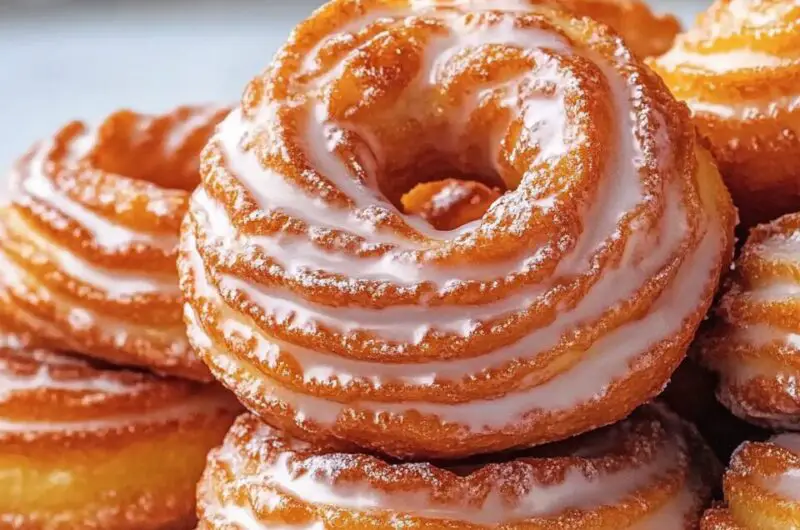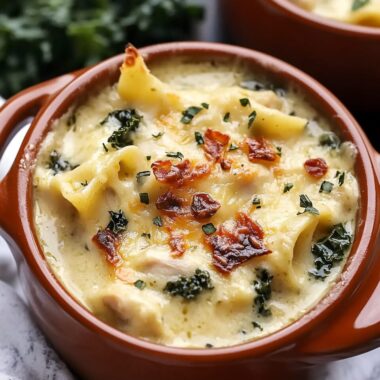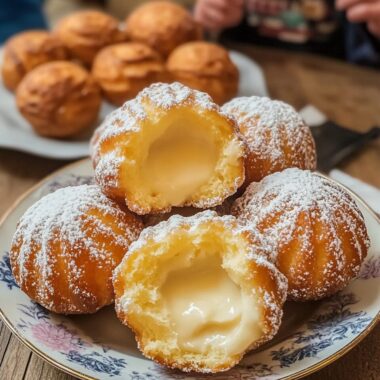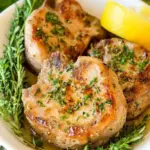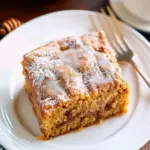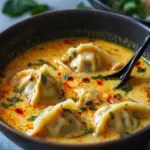What Makes a Cruller a Cruller
Unlike yeast-raised donuts or cakey varieties, crullers are made from a dough similar to French pâte à choux—the same base used in éclairs and cream puffs. The result is a pastry that puffs when fried, forming light, eggy interiors and crisp, golden exteriors. Their signature ridged shape is achieved by piping the dough through a large French star tip into ring shapes. Once fried, they are dipped in a smooth glaze that seeps slightly into the grooves, creating a glossy sheen and gentle sweetness in every bite.
While the term “cruller” can refer to various styles of twisted or ridged donuts, the French cruller stands apart due to its airy texture and unique preparation. The frying method and choice of dough elevate it from your everyday donut into something extraordinary—worthy of brunch spreads, holiday mornings, or as a show-stopping homemade treat.
The Importance of Freezing Before Frying
One of the key techniques in this recipe is freezing the piped crullers before frying. This isn’t just for convenience—it ensures that the delicate ridges from the piping stay intact as the dough hits the hot oil. Frying from frozen keeps the shape clean, controls the expansion, and results in perfectly round crullers with evenly defined texture. It also allows you to prep the dough in advance and fry on demand, which is especially helpful for serving fresh crullers to guests or during busy mornings.
The Art of the Dough
Pâte à choux may seem intimidating, but it’s easier than it appears. The technique involves cooking the flour into the wet ingredients to gelatinize the starches, forming a thick dough that’s then beaten with eggs until it becomes silky and pipeable. In this version, both granulated and brown sugar are used to add a subtle depth of flavor, while whole milk provides richness and moisture. The key is achieving the right consistency—a glossy dough that holds its shape but is soft enough to pipe. A stand mixer makes this step more manageable, but it can also be done with a strong arm and a sturdy spatula.
The addition of egg whites alongside whole eggs enhances the lightness of the dough, contributing to the airy structure once fried. Timing is crucial here—beating the dough too little or adding eggs too quickly can result in uneven consistency. But when done right, you’ll have a perfect dough that behaves beautifully in the piping bag.
Shaping Crullers Like a Pro
A large French star tip (like Ateco 869) is essential for creating the cruller’s signature ridges. These not only give the crullers their visual appeal but also increase surface area, helping the exterior to fry up crisp and beautifully golden. Piping rings onto small parchment squares lets you lift and transfer them into the oil without warping the shape. This is a trick used in many professional kitchens and ensures that your finished pastries look as good as they taste.
Freezing the piped dough also allows you to store extras and fry them as needed. You can batch prepare a dozen crullers and simply grab a few from the freezer whenever the craving hits—no need to start from scratch every time.
The Sweet Simplicity of Maple Glaze
The maple glaze is the final touch that transforms these pastries from impressive to irresistible. Made with powdered sugar, real maple syrup, a touch of milk, and salt, it’s simple yet incredibly flavorful. The salt enhances the maple’s complexity, and the glaze’s flowing consistency allows it to coat the crullers evenly without dripping excessively. While maple syrup is classic, you can easily experiment with flavor variations—vanilla bean, orange zest, cinnamon, or even espresso—for a signature glaze that matches the occasion.
Dipping the crullers while they’re still slightly warm allows the glaze to adhere and lightly melt into the surface, ensuring each bite is glossy, sweet, and satisfying. Letting the glaze set at room temperature creates the ideal texture—slightly crackly on the outside and soft within.
Perfect for Breakfast, Brunch, or Dessert
Crullers are versatile in their appeal. Serve them in the morning with hot coffee or tea for a café-style breakfast experience. Add them to a weekend brunch buffet for an elegant touch that outshines store-bought pastries. Or offer them as a unique dessert paired with whipped cream and fresh fruit. Their lightness means they don’t feel overly indulgent, even though they look and taste like a special treat.
They also make beautiful gifts. Boxed up in parchment with a ribbon, homemade French crullers are a thoughtful and delightful offering that showcases your culinary skills and effort.
Storage and Make-Ahead Tips
French crullers are best enjoyed the day they’re fried, ideally within a few hours of glazing. However, you can prepare and freeze the piped dough up to a week in advance. Once fried and glazed, they’ll keep for about a day at room temperature, but their texture will soften over time. Avoid refrigerating them, as it can cause the glaze to weep and the pastry to lose its delicate structure.
If you have leftovers, a quick toast in an air fryer or oven (350°F for 3–5 minutes) can help restore some of the outer crispness—though they’ll never quite match the perfection of fresh-fried.
Nutritional Profile
Each cruller comes in at approximately 231 calories, with moderate amounts of fat and carbohydrates. While they are certainly a treat, they are less dense than many traditional donuts, thanks to the airy dough. The use of real butter and milk adds richness, while the relatively small size helps with portion control. The glaze contributes sweetness without overwhelming, and the dough itself contains only a modest amount of sugar.
Conclusion
French crullers offer a refined twist on the traditional donut experience—light, crisp, delicately sweet, and beautifully crafted. With this recipe, you don’t need to be a pastry chef to create café-worthy results. By mastering a few simple techniques—cooking and cooling the dough, piping with a star tip, freezing before frying—you’ll unlock the secret to a treat that looks elegant and tastes even better. Whether you’re planning a brunch, spoiling your guests, or just treating yourself, these maple-glazed crullers bring the joy of French pâtisserie right into your home kitchen. Once you taste your first homemade cruller, you’ll wonder why you ever settled for anything less.

